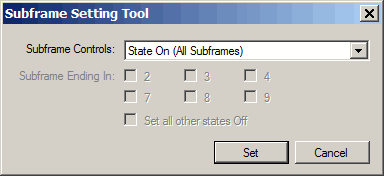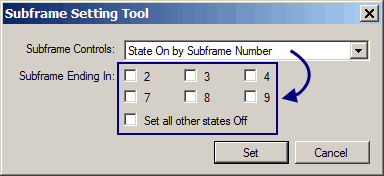Open topic with navigation
UCI—General Settings
The Physical Uplink Control Channel (PUCCH) carries the uplink control information (UCI). The data type and data choices depend on the selected PUCCH format in accordance with 3GPP TS 36.211. Two PUCCH format settings are available, one for non-SRS subframes, one for the cell specific Sounding Reference Signal (SRS) subframes.
The setting for this window cannot be changed while transmitting the signal (State On button clicked). To change settings, first click the State Off button to stop the signal.
The software does not use these settings when it is controlling multiple instruments as shown in the tree view.
Buttons
|

|
This button indicates that the current real-time settings have been applied to the instrument—no action is required. This button is not available when the Apply Needed button is active. When using multiple instruments as shown in the tree view, this button is not displayed.
|
|

|
This button displays in place of the Settings Current button. It indicates that the instrument settings are not currrent and need to be updated with the new software settings. Click this button to update the insturment's settings. This button shows in all windows regardless of where the change was made. When using multiple instruments as shown in the tree view, this button is not displayed.
[:SOURce]:RADio:LTE:TDD[:BBG]:ULINk:APPLy
[:SOURce]:RADio:LTE:TDD[:BBG]:ULINk:APPLy?
|

Click this button to launch the Subframe Setting Tool  dialog box. Then use the dialog box to set the states of the subframes shown in the Subframe Status tab. To set the subframe states using the tool:
dialog box. Then use the dialog box to set the states of the subframes shown in the Subframe Status tab. To set the subframe states using the tool:

-
Click the drop-down arrow shown in the  Subframe Controls field.
Subframe Controls field.

-
Make the subframe state selection.
-
If the  check boxes below the Subframe Controls field become active after making a selection such as with State On by Subframe Number, click (check) the needed boxes to finish configuring the subframe states.
check boxes below the Subframe Controls field become active after making a selection such as with State On by Subframe Number, click (check) the needed boxes to finish configuring the subframe states.

- Click Set to implement the settings.
Alternatively set or modify each subframe state manually from within the Subframe Status tab by clicking on a subframe and use the drop-down arrow to select a different state.
1. Non-SRS Subframe
Format
|
Choices
|
|
|
|
Normal CP
|
Format 1
|
Format 2
|
|
|
Format 1a
|
Format 2a
|
|
|
Format 1b
|
Format 2b
|
|
|
|
|
|
Extended CP
|
Format 1
|
Format 2
|
|
|
Format 1a
|
|
|
|
Format 1b
|
|
Default: Format 1
Double-click or use the drop-down menu to select the PUCCH format.
[:SOURce]:RADio:LTE:TDD[:BBG]:ULINk:PUCCh:FORMat F1|F1A|F1B|F2|F2A|F2B
[:SOURce]:RADio:LTE:TDD[:BBG]:ULINk:PUCCh:FORMat?
Data Type
Choice: SR | 1-bit HARQ-ACK | 2-bit HARQ-ACK | CQI | CQI + 1-bit HARQ-ACK | CQI + 2-bit HARQ-ACK
Default: SR
Coupling: Active with extended Cyclic Prefix and Format 2. otherwise display only based on Format selection.
The PUCCH data type is determined by the selected format as shown in the table below. When Format 2 is used with the extended Cyclic Prefix, the PUCCH data type is selectable.
When the data type is CQI or is an element of the data type, you can use the CQI Data parameter to set the CQI data.
|
Format 1
|
SR ( Scheduling Request)
|
N/A
|
N/A
|
N/A
|
|
Format 1a
|
1- Bit HARQ-ACK
|
ACK | NACK
|
BPSK
|
1
|
|
Format 1b
|
2-Bit HARQ-ACK
|
ACK ACK | ACK NACK | NACK ACK | NACK NACK
|
QPSK
|
2
|
|
Format 2
|
Normal CP: CQI;
|
CQI Data
|
QPSK
|
20
|
|
Extended CP:
CQI
CQI +1-Bit HARQ-ACK
CQI+ 2-Bit HARQ-ACK
|
CQI Data
CQI Data + ACK | NACK
CQI Data + ACK ACK | ACK NACK | NACK ACK | NACK NACK
|
QPSK
|
20
|
|
Format 2a*
|
CQI + 1-Bit HARQ-ACK
|
CQI Data + ACK | NACK
|
QPSK+BPSK
|
21
|
|
Format 2b*
|
CQI + 2- Bit HARQ-ACK
|
CQI Data + ACK ACK | ACK NACK | NACK ACK | NACK NACK
|
QPSK+BPSK
|
22
|
Use the command when the Cyclic Prefix is set to Extended and the Format is set to 2. For any other Cyclic Prefix and Format setting, only the query is available.
[:SOURce]:RADio:LTE:TDD[:BBG]:ULINk:PUCCh:DATA:TYPE CQI|CQI_ACK1B|CQI_ACK2B
[:SOURce]:RADio:LTE:TDD[:BBG]:ULINk:PUCCh:DATA:TYPE?
1-Bit HARQ-ACK Data
Choices: ACK | NACK
Default: ACK
Coupling: Active when the Data Type parameter includes 1-Bit HARQ-ACK
Double-click or use the drop-down menu to select the 1-bit HARQ-ACK data.
[:SOURce]:RADio:LTE:TDD[:BBG]:ULINk:PUCCh:HARQ:OBIT:DATA ACK|NACK
[:SOURce]:RADio:LTE:TDD[:BBG]:ULINk:PUCCh:HARQ:OBIT:DATA?
2-Bit HARQ-ACK Data
Choices: ACK ACK | ACK NACK | NACK ACK | NACK NACK
Default: ACK ACK
Coupling: Active when the Data Type parameter includes 2-Bit HARQ-ACK
Double-click or use the drop-down menu to select the 2-bit HARQ-ACK data.
[:SOURce]:RADio:LTE:TDD[:BBG]:ULINk:PUCCh:HARQ:TBIT:DATA ACK_ACK|ACK_NACK|NACK_ACK|NACK_NACK
[:SOURce]:RADio:LTE:TDD[:BBG]:ULINk:PUCCh:HARQ:TBIT:DATA?
CQI Data
Choices: PN9 | PN15 | User
Default: PN9
Coupling: Active when CQI is or part of the displayed Data Type— Format selections of 2, 2a, or 2b
Use the Data Source Selection dialog box to select the CQI data.
|
PN9
|
Uses PN9 sequence as data bits
|
|
PN15
|
Uses PN15 sequence as data bits
|
|
User
|
Uses a user-defined sequence up to 13-bits, represented by binary data.
|
[:SOURce]:RADio:LTE:TDD[:BBG]:ULINk:PUCCh:CQI:DATA:TYPE PN9|PN15|USER
[:SOURce]:RADio:LTE:TDD[:BBG]:ULINk:PUCCh:CQI:DATA:TYPE?
If USER is the data type, use the following command to set the string patttern. To set the pattern, use "0", "1", or a combination of the two "011100" up to the number set in the CQI Data Length parameter.
[:SOURce]:RADio:LTE:TDD[:BBG]:ULINk:PUCCh:CQI:DATA:USER "<pattern>"
[:SOURce]:RADio:LTE:TDD[:BBG]:ULINk:PUCCh:CQI:DATA:USER?
CQI Data Length
Range: 1 to 13
Default: 4
Coupling: Active when CQI is or part of the displayed Data Type— Format selections of 2, 2a, or 2b
Enter the data length of PUCCH CQI data.
[:SOURce]:RADio:LTE:TDD[:BBG]:ULINk:PUCCh:CQI:DATA:LENGth <val>
[:SOURce]:RADio:LTE:TDD[:BBG]:ULINk:PUCCh:CQI:DATA:LENGth?
2. SRS Subframe
Sounding reference signals (SRS) subframe can be configured for a specific cell in the base station.
Format
Choice: Format 1 | Format 1a | Format 1b
Default: Format 1
Double-click or use the drop-down menu to select the PUCCH format for the cell specific SRS subframe.
[:SOURce]:RADio:LTE:TDD[:BBG]:ULINk:PUCCh:SRSSubframe:FORMat F1|F1A|F1B
[:SOURce]:RADio:LTE:TDD[:BBG]:ULINk:PUCCh:SRSSubframe:FORMat?
Data Type
Choices: SR (Scheduling Request) | 1-bit HARQ_ACK | 2- bit HARQ-ACK
Default: SR
Displays the PUCCH data type for the cell specific SRS subframe.The data type is determined by the PUCCH format selected for the Cell Specific SRS subframe.
[:SOURce]:RADio:LTE:TDD[:BBG]:ULINk:PUCCh:SRSSubframe:DATA:TYPE?
1-Bit HARQ-ACK Data
Choices: ACK | NACK
Default: ACK
Coupling: Active with the Cell specific SRS Subframe Format 1a selection.
Double-click or use the drop-down menu to select the 1-bit HARQ-ACK data for the cell specific SRS subframe.
[:SOURce]:RADio:LTE:TDD[:BBG]:ULINk:PUCCh:SRSSubframe:HARQ:OBIT:DATA ACK|NACK
[:SOURce]:RADio:LTE:TDD[:BBG]:ULINk:PUCCh:SRSSubframe:HARQ:OBIT:DATA?
2-Bit HARQ-ACK Data
Choices: ACK ACK | ACK NACK | NACK ACK | NACK NACK
Default: ACK-NACK
Coupling: Active with the Cell specific SRS Subframe Format 1b selection.
Double-click or use the drop-down menu to select the 2-bit HARQ-ACK data for the cell specific SRS subframe.
[:SOURce]:RADio:LTE:TDD[:BBG]:ULINk:PUCCh:SRSSubframe:HARQ:TBIT:DATA ACK_ACK|ACK_NACK|NACK_ACK|NACK_NACK
[:SOURce]:RADio:LTE:TDD[:BBG]:ULINk:PUCCh:SRSSubframe:HARQ:TBIT:DATA?





